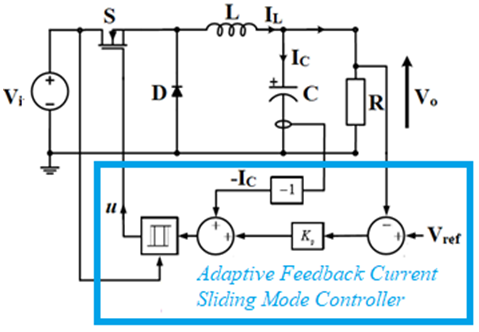On modeling and real-time simulation of a robust adaptive controller applied to a multicellular power converter
DOI:
https://doi.org/10.20998/2074-272X.2022.6.08Keywords:
multicellular converters, sliding mode control, high switching frequency, hysteresis modulationAbstract
Introduction. This paper describes the simulation and the robustness assessment of a DC-DC power converter designed to interface a dual-battery conversion system. The adopted converter is a Buck unidirectional and non-isolated converter, composed of three cells interconnected in parallel and operating in continuous conduction mode. Purpose. In order to address the growing challenges of high switching frequencies, a more stable, efficient, and fixed-frequency-operating power system is desired. Originality. Conventional sliding mode controller suffers from high-frequency oscillation caused by practical limitations of system components and switching frequency variation. So, we have explored a soft-switching technology to deal with interface problems and switching losses, and we developed a procedure to choose the high-pass filter parameters in a sliding mode-controlled multicell converter. Methods. We suggest that the sliding mode is controlled by hysteresis bands as the excesses of the band. This delay in state exchanges gives a signal to control the switching frequency of the converter, which, in turn, produces a controlled trajectory. We are seeking an adaptive current control solution to address this issue and adapt a variable-bandwidth of the hysteresis modulation to mitigate nonlinearity in conventional sliding mode control, which struggles to set the switching frequency. Chatter problems are therefore avoided. A boundary layer-based control scheme allows multicell converters to operate with a fixed-switching-frequency. Practical value. Simulation studies in the MATLAB / Simulink environment are performed to analyze system performance and assess its robustness and stability. Thus, our converter is more efficient and able to cope with parametric variation.
References
Hamdi R., Hamida A.H., Bennis O., Babaa F. HM-Based SMVC with Adaptive Feedforward Controller Applied to DC-DC Converter. 2020 International Conference on Electrical and Information Technologies (ICEIT), 2020, pp. 1-6. doi: https://doi.org/10.1109/ICEIT48248.2020.9113220.
Do W., Eguchi K., Shibata A. An analytical approach for parallel switched capacitor converter. Energy Reports, 2020, vol. 6, pp. 338-342. doi: https://doi.org/10.1016/j.egyr.2020.11.233.
Li H., Jiang X., Zou Y., Liu C. A time-domain stability analysis method for paralleled LLC resonant converter system based on Floquet theory. Microelectronics Reliability, 2020, vol. 114, art. no. 113849. doi: https://doi.org/10.1016/j.microrel.2020.113849.
Ben Said S., Ben Saad K., Benrejeb M. HIL simulation approach for a multicellular converter controlled by sliding mode. International Journal of Hydrogen Energy, 2017, vol. 42, no. 17, pp. 12790-12796. doi: https://doi.org/10.1016/j.ijhydene.2017.01.198.
Djondiné P. Overview of Control Techniques for Multicellular Converter. Journal of Engineering Sciences, 2018, vol. 5, no. 1, pp. E10-E14. doi: https://doi.org/10.21272/jes.2018.5(1).e3.
Engelkemeir F., Gattozzi A., Hallock G., Hebner R. An improved topology for high power soft-switched power converters. International Journal of Electrical Power & Energy Systems, 2019, vol. 104, pp. 575-582. doi: https://doi.org/10.1016/j.ijepes.2018.07.049.
Romashko V.Y., Batrak L.M., Abakumova O.O. Step-up/step-down regulators in maximum power transmission mode. Electrical Engineering & Electromechanics, 2022, no. 2, pp. 18-22. doi: https://doi.org/10.20998/2074-272X.2022.2.03.
Merlin Suba G., Kumaresan M. Design of LLC resonant converter with silicon carbide MOSFET switches and nonlinear adaptive sliding controller for brushless DC motor system. Electrical Engineering & Electromechanics, 2022, no. 4, pp. 34-43. doi: https://doi.org/10.20998/2074-272X.2022.4.05.
Bouraghda S., Sebaa K., Bechouat M., Sedraoui M. An improved sliding mode control for reduction of harmonic currents in grid system connected with a wind turbine equipped by a doubly-fed induction generator. Electrical Engineering & Electromechanics, 2022, no. 2, pp. 47-55. doi: https://doi.org/10.20998/2074-272X.2022.2.08.
Patin N. Power Electronics Applied to Industrial Systems and Transports. Elsevier, 2016. 272 p. doi: https://doi.org/10.1016/C2015-0-04476-8.
Kolli A., Gaillard A., De Bernardinis A., Bethoux O., Hissel D., Khatir Z. A review on DC/DC converter architectures for power fuel cell applications. Energy Conversion and Management, 2015, vol. 105, pp. 716-730. doi: https://doi.org/10.1016/j.enconman.2015.07.060.
Al-Baidhani H., Kazimierczuk M.K., Salvatierra T., Reatti A., Corti F. Sliding-Mode Voltage Control of Dynamic Power Supply for CCM. 2019 IEEE International Symposium on Circuits and Systems (ISCAS), 2019, pp. 1-5. doi: https://doi.org/10.1109/ISCAS.2019.8702628.
Ma G., Wang B., Xu D., Zhang L. Switching control strategy based on non-singular terminal sliding mode for buck converter in auxiliary energy source. Energy Procedia, 2018, vol. 145, pp. 139-144. doi: https://doi.org/10.1016/j.egypro.2018.04.023.
Wu Y., Huangfu Y., Ma R., Ravey A., Chrenko D. A strong robust DC-DC converter of all-digital high-order sliding mode control for fuel cell power applications. Journal of Power Sources, 2019, vol. 413, pp. 222-232. doi: https://doi.org/10.1016/j.jpowsour.2018.12.049.
Das S., Salim Qureshi M., Swarnkar P. Design of integral sliding mode control for DC-DC converters. Materials Today: Proceedings, 2018, vol. 5, no. 2, pp. 4290-4298. doi: https://doi.org/10.1016/j.matpr.2017.11.694.
Pandey S.K., Patil S.L., Ginoya D., Chaskar U.M., Phadke S.B. Robust control of mismatched buck DC–DC converters by PWM-based sliding mode control schemes. Control Engineering Practice, 2019, vol. 84, pp. 183-193. doi: https://doi.org/10.1016/j.conengprac.2018.11.010.
Naik B.B., Mehta A.J. Sliding mode controller with modified sliding function for DC-DC Buck Converter. ISA Transactions, 2017, vol. 70, pp. 279-287. doi: https://doi.org/10.1016/j.isatra.2017.05.009.

Downloads
Published
How to Cite
Issue
Section
License
Copyright (c) 2022 R. Hamdi, A. Hadri Hamida, O. Bennis

This work is licensed under a Creative Commons Attribution-NonCommercial 4.0 International License.
Authors who publish with this journal agree to the following terms:
1. Authors retain copyright and grant the journal right of first publication with the work simultaneously licensed under a Creative Commons Attribution License that allows others to share the work with an acknowledgement of the work's authorship and initial publication in this journal.
2. Authors are able to enter into separate, additional contractual arrangements for the non-exclusive distribution of the journal's published version of the work (e.g., post it to an institutional repository or publish it in a book), with an acknowledgement of its initial publication in this journal.
3. Authors are permitted and encouraged to post their work online (e.g., in institutional repositories or on their website) prior to and during the submission process, as it can lead to productive exchanges, as well as earlier and greater citation of published work.




